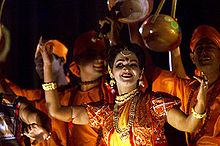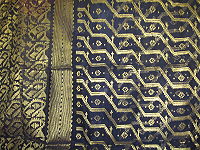- Culture of Bangladesh
-
Bangladesh has a long history in its culture. The land, the rivers, and the lives of the common people formed a rich heritage with marked differences from neighbouring regions. It has evolved over the centuries and encompasses the cultural diversity of several social groups of Bangladesh. The Bengal Renaissance of the 19th and early 20th centuries, noted Bengali writers, saints, authors, scientists, researchers, thinkers, music composers, painters and film-makers have played a significant role in the development of Bengali culture. The Bengal Renaissance contained the seeds of a nascent political Indian nationalism and was the precursor in many ways to modern Indian artistic and cultural expression. The culture of Bangladesh is composite and over centuries has assimilated influences of Hinduism, Jainism, Buddhism, Islam, and Christianity. It is manifested in various forms, including music, dance and drama; art and craft; folklore and folktales; languages and literature, philosophy and religion, festivals and celebrations, as also in a distinct cuisine and culinary tradition.
Contents
Music, dance, drama and film
Main article: Music of BangladeshThe music and dance styles of Bangladesh may be divided into three categories, classical, folk and modern. The classical style has been influenced by other prevalent classical forms of music and dances of the Indian subcontinent, and accordingly show some influences dance forms like Bharata Natyam and Kuchipudi. The folk and tribal music and dance forms of Bangladesh are of indigenous origin and rooted to the soil of Bangladesh. Several dancing styles in vogue in the north-eastern part of the Indian subcontinent, like Monipuri and Santal dances, are also practiced in Bangladesh, but Bangladesh has developed its own distinct dancing styles. Bangladesh has a rich tradition of folk songs, with lyrics rooted into vibrant tradition and spirituality, mysticism and devotion. Such folk songs also revolve round several other themes, including love themes. Most prevalent of folk songs and music traditions include Bhatiali, Baul, Marfati, Murshidi and Bhawaiya. Lyricists like Lalon Shah, Hason Raja, Kangal Harinath, Romesh Shill, Abbas Uddin and many unknown anonymous lyrists have enriched the tradition of folk songs of Bangladesh. In relatively modern context, Rabindra Sangeet and Nazrul geeti form precious cultural heritage of Bangladesh. In recent time, western influences have given rise to several quality rock bands, particularly in urban centers like Dhaka. Several musical instruments, some of them of indigenous origin, are used in Bangladesh, and major musical instruments used are bamboo flute (banshi), drums (dhol), a single stringed instrument named ektara, a four stringed instrument called dotara, a pair of metal bawls used for rhythm effect called mandira. Currently, several musical instruments of western origin like guitar, drums, and saxophone are also used, sometimes alongside the traditional instruments.
Festivals and celebrations
Festivals and celebrations are integral part of the culture of Bangladesh. Prominent and widely celebrated festivals are Pohela Baishakh, Independence day, National Mourning Day, Eid-ul-Fitr, Eid-ul-Azha, Muharram, Durga puja, and Language Movement Day.
Eid ul-Fitr
Main article: Eid ul-FitrAs the most important religious festival for the majority Muslims, the celebration of Eid ul-Fitr has become a part of the culture of Bangladesh. The government of Bangladesh declares holiday for three days on Eid-ul Fitar. People living in towns having their families or parents in villages go to their country homes to meet relatives and celebrate the festival together. All outgoing public transport from the major cities become highly crowded and in many cases the fares tend to rise in spite of government restrictions.
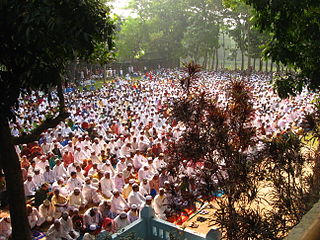 Males from around the Barashalghar union of Comilla's Debidwar upazila can be seen attending Khutbah as part of the Eid-ul-Adha prayers on 7 November, 2011.
Males from around the Barashalghar union of Comilla's Debidwar upazila can be seen attending Khutbah as part of the Eid-ul-Adha prayers on 7 November, 2011.
On Eid day, Eid prayers are held all over the country, in open areas like fields or else inside mosques. In Dhaka, the largest Eid prayer is held at the national Eidgah. All major mosques including the Baitul Mukarram also holds prayers. The biggest congregation of Bangladesh is held at Sholakia in Kishoreganj, where about half a million people join the Eid prayer.[1] Banglapedia article on Eid-ul FitarAfter the Eid prayers, people return home, visit each other's home and eat sweet dishes called Shirni. Throughout the day gentlemen embrace each other. It is also customary for junior members of the society to touch the feet of the seniors, and seniors returning blessings (sometimes with a small sum of money as a gift). In the rural areas Eid festival is observed with great fanfare. In some areas Eid fares are arranged. Different types of games including boat race, kabbadi, other traditional Bangladeshi games as well as modern games like football and cricket are played on this occasion. In urban areas people play music, visit each other's houses and eat special food. Watching movies and television programs has also become an integral part of Eid celebration in urban areas. All local TV channels air special program for several days for this occasion.
Eid ul-Adha
Main article: Eid ul-AdhaThe celebration of Eid ul-Adha is similar to Eid ul-Fitr in many ways. The only big difference is the Qurbani or sacrifice of domestic animals on Eid ul-Adha. Numerous temporary marketplaces of different sizes called Haat operate in the big cities for sale of Qurbani animals (usually cows and goats). In the morning on the Eid day, immediately after the prayer, affluent people slaughter their animal of choice. Less affluent people also take part in the festivity by visiting houses of the affluent who are taking part in qurbani. After the qurbani a large portion of the meat is given to the poor people. Although the religious doctrine allows the sacrifice anytime over a period of three days starting from the Eid day, most people prefer to perform the ritual on the first day of Eid. However, the public holiday spans over three to four days. Many people from the big cities go to their ancestral houses/homes in the villages to share the joy of the festival with friends and relatives.
Pohela Boishakh
Main article: Pohela BoishakhPôhela Boishakh is the first day of the Bangla Calendar. It is usually celebrated on the 14th of April. Pohela Boishakh marks the start day of the crop season. Usually on Pôhela Boishakh, the home is thoroughly scrubbed and cleaned; people bathe early in the morning and dress in fine clothes. They spend much of the day visiting relatives, friends, and neighbours and going to fair. Fairs are arranged in many parts of the country where various agricultural products, traditional handicrafts, toys, cosmetics, as well as various kinds of food and sweets are sold. The fairs also provide entertainment, with singers, dancers and traditional plays and songs. Horse races, bull races, bullfights, cockfights, flying pigeons, boat racing were once popular. All gatherings and fairs consist a wide spread of Bengali food and sweets. The most colourful New Year's Day festival takes place in Dhaka. Large numbers of people gather early in the morning under the banyan tree at Ramna Park where Chhayanat artists open the day with Rabindranath Tagore's famous song, Esho, he Boishakh, Esho Esho (Come, Year, Come, Come). A similar ceremony welcoming the new year is also held at the Institute of Fine Arts, University of Dhaka. Students and teachers of the institute take out a colourful procession and parade round the campus. Social and cultural organisations celebrate the day with cultural programmes. Newspapers bring out special supplements. There are also special programmes on radio and television.Prior to this day, special discounts on clothes, furniture, electronics and various deals and shopping discounts are available. Special line of sarees, usually cottons, white sarees with red print/embroidery is sold before this day as everyone dresses up for this day. jasmine flowers are also a huge sale for this event which adorns the women's hair.
Language Movement Day
Main article: Language Movement Day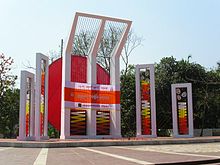 Shaheed Minar, or the Martyr's monument, located near the Dhaka Medical College and Hospital.
Shaheed Minar, or the Martyr's monument, located near the Dhaka Medical College and Hospital.
Language Movement Day is a unique part of the culture of Bangladesh. Every year on February 21 this day is observed to pay tribute to the martyrs who sacrificed their lives to establish Bengali as the official language of then East Pakistan in 1952. The mood of the day is sad and humble. The celebration of Language Movement Day goes on the entire month of February. Ekushey Book Fair is a book fair arranged to mark this occasion every year. The fair has also become an integral part of the culture of Bangladesh. Authors and readers in Bangladesh eagerly await the fair each year. To commemorate this movement, Shaheed Minar, a solemn and symbolic sculpture, was erected in the place of the massacre. Today the Shaheed Minar is the centre of cultural activities in Dhaka. On the morning of February 21 each year, people from all walks of life including the national leaders pay tribute to the martyrs by leaving flowers at Shaheed Minar. A very melodious and melancholy song, Amar Bhaier Rokte Rangano, written by Abdul Gaffar Choudhury and composed by Altaf Mahmud, is played repeatedly in electronic media and cultural gatherings throughout the month, and especially on February 21. This song, too, has become a symbolic mark of culture of Bangladesh.
Weddings
Main article: Bengali marriageA traditional wedding is arranged by Ghotoks (matchmakers), who are typically friends or relatives of the couple. The matchmakers facilitate the introduction, and also help agree the amount of any settlement. Bengali weddings are traditionally in five parts: first it is the bride and groom's Mehendi Shondha,the bride's Gaye Holud, the groom's Gaye Holud, the Beeya and the Bou Bhaat. These often take place on separate days. The first event in a wedding is an informal one: the groom presents the bride with a ring marking the "engagement" which is gaining popularity. For the mehendi shondha the bride's side apply henna to each other as well as the bride For the bride's Gaye Holud, the groom's family - except the groom himself - go in procession to the bride's home.Bride's friends and family apply turmeric paste to her body as a part of Gaye Hoof bride, and they are traditionally all in matching clothes, mostly orange in colour. The bride is seated on a dais, and the henna is used to decorate the bride's hands and feet with elaborate abstract designs. The sweets are then fed to the bride by all involved, piece by piece. The actual wedding ceremony "Biye" follows the Gaye Holud ceremonies. The wedding ceremony is arranged by the bride's family. On the day, the younger members of the bride's family barricade the entrance to the venue, and demand a sort of admission charge from the groom in return for allowing him to enter. The bride and groom are seated separately, and a Kazi (authorized person by the govt. to perform the wedding), accompanied by the parents and a Wakil (witness) from each side formally asks the bride for her consent to the union, and then the groom for his. The bride's side of the family tries to play some kind of practical joke on the groom such as stealing the groom's shoe. The reception, also known as Bou-Bhaat (reception), is a party given by the groom's family in return for the wedding party. It is typically a much more relaxed affair, with only the second-best wedding outfit being worn.
Sports
Main article: Sport in BangladeshFootball, cricket and kabaddi. Kabaddi is the national sport of Bangladesh. Cricket is a game which has a massive and passionate following in Bangladesh. Bangladesh has joined the elite group of countries eligible to play Test cricket since 2000. The Bangladesh national cricket team goes by the nickname of the Tigers—after the Royal Bengal Tiger. The people of Bangladesh enjoy watching live sports. Whenever there is a cricket or football match between popular local teams or international teams in any local stadium significant number of spectators gather to watch the match live. The people also celebrate major victories of the national team with a great enthusiasm for the live game. Victory processions are the most common element in such celebrations. A former prime minister even made an appearance after an international one day cricket match in which Bangladesh beat Australia, she came to congratulate the victory. Also in late 2006/early 2007, football legend Zinedine Zidane paid a visit to local teams and various events thanks to the invite of Nobel Peace Prize winner Dr. Muhammad Yunus.
Religion in Bangladesh
Main article: Religion in Bangladesh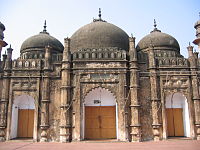 Khan Mohammad Mirdha's mosque (built 1706) at Atish Khana, in Old Dhaka, Bangladesh.
Khan Mohammad Mirdha's mosque (built 1706) at Atish Khana, in Old Dhaka, Bangladesh.
Bangladesh is ethnically homogeneous, with Bengalis comprising 98% of the population. The majority of Bangladeshis (about 90%) are Muslims, and a small number of Hindus, Christians and Buddhists are also in the country. But due to immense cultural diversity, multiple dialects, hybridization of social traits and norms as well as cultural upbringing, Bangladeshis cannot be stereotyped very easily, except for the only fact that they are very resilient in nature. People of different religions perform their religious rituals with festivity in Bangladesh. The Government has declared National Holidays on all important religious festivals of the four major religions. Durga Puja, Christmas and Buddha Purnima are celebrated with enthusiasm in Bangladesh. All of these form an integral part of the cultural heritage of Bangladesh. See also *Islam in Bangladesh *Hinduism in Bangladesh *Christianity in Bangladesh *Buddhism in Bangladesh
Lifestyle in Bangladesh
Cuisine
Main article: Bengali food Panta Ilish - a traditional platter of Panta bhat with fried Hilsa slice, supplemented with dried fish (Shutki), pickles (Achar), dal, green chillies and onion - is a popular serving for the Pohela Boishakh festival.
Panta Ilish - a traditional platter of Panta bhat with fried Hilsa slice, supplemented with dried fish (Shutki), pickles (Achar), dal, green chillies and onion - is a popular serving for the Pohela Boishakh festival.
Bangladesh is famous for its distinctive culinary tradition, and delicious food, snacks and savories. Boiled rice constitutes the staple food, and is served with a variety of vegetables, fried as well as curries, thick lentil soups, and fish and meat preparations of mutton and chicken, and more rarely pork and beef by certain groups. Sweetmeats of Bangladesh are mostly milk based, and consist of several delights including Roshgulla, Sandesh, Rasamalai, Gulap Jamun, Kalo Jamun, Chom Chom. Several other sweet preparations are also available. Bengali cuisine is rich and varied with the use of many specialized spices and flavours. Fish is the dominant source of protein, cultivated in ponds and fished with nets in the fresh-water rivers of the Ganges delta. More than forty types of mostly freshwater fish are common, including carp varieties like rui (rohu), katla, magur (catfish), chingŗi (prawn or shrimp), as well as shuţki (dried sea fish). Salt water fish (not sea fish though) Ilish (hilsa ilisha) is very popular among Bengalis, can be called an icon of Bengali cuisine.
Dress
Portion of a sari woven at Sonargaon
Bangladeshi people have unique dress preferences. Bangladeshi men wear Kurta on religious and cultural occasions, lungi as casual wear and shirt-pant on formal occasions. Salwar Kameez and Sharee are the main dresses of Bangladeshi women. Weaving the fabric for these dresses is a traditional art in Bangladesh.
See also
External links
Bengali culture General Art · Architecture of Bengal · Architecture of Bangladesh · Calendar · Cinema · Cuisine · History · Language · Literature · Music · Poetry · Renaissance · Script · Sport (Bangladesh) · Theatre · Wedding · Bengali people (list)
Specific Dhaki · Fairs in Birbhum · Folk literature · Jatra · Maimansingha Gitika · Nabanna · Panjika · Pohela Baishakh · Poush Mela · Rabindra Sangeet · Tarja
Folk songs and dances Crafts Bankura horse · Craft centres in West Bengal · Dhakai · Dhokra · Jamdani · Kantha · Nakshi Kantha · Sholapith
Culture of Asia Sovereign
states- Afghanistan
- Armenia
- Azerbaijan
- Bahrain
- Bangladesh
- Bhutan
- Brunei
- Burma (Myanmar)
- Cambodia
- People's Republic of China
- Cyprus
- East Timor (Timor-Leste)
- Egypt
- Georgia
- India
- Indonesia
- Iran
- Iraq
- Israel
- Japan
- Jordan
- Kazakhstan
- North Korea
- South Korea
- Kuwait
- Kyrgyzstan
- Laos
- Lebanon
- Malaysia
- Maldives
- Mongolia
- Nepal
- Oman
- Pakistan
- Philippines
- Qatar
- Russia
- Saudi Arabia
- Singapore
- Sri Lanka
- Syria
- Tajikistan
- Thailand
- Turkey
- Turkmenistan
- United Arab Emirates
- Uzbekistan
- Vietnam
- Yemen
States with limited
recognition- Abkhazia
- Nagorno-Karabakh
- Northern Cyprus
- Palestine
- Republic of China (Taiwan)
- South Ossetia
Dependencies and
other territoriesCategories:- Bangladeshi culture
Wikimedia Foundation. 2010.

